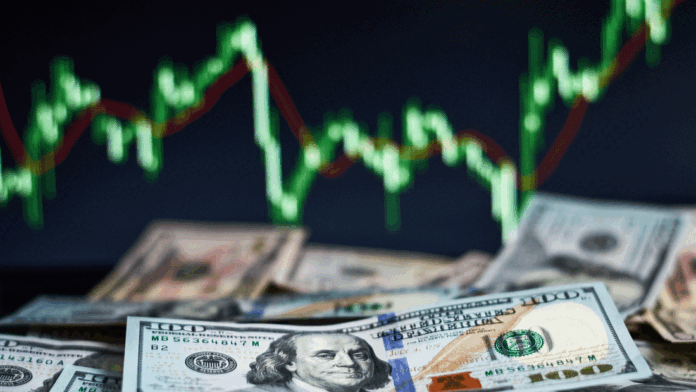[ad_1]
ECONOMYNEXT – Sri Lanka’s rupee will be taken to 270 to the US dollar, President Ranil Wickremesinghe has said on a visit to the hill country, after saying in March that the currency will be taken to 280 to the US dollar by June.
“The rupee strengthen now,” President Wickremesinghe told a member of the public who said fertilizer prices were high, while he was inspecting Sri Lanka’s Pekoe Trail on a tea estate in Pussellawa.
“We will take it to 270. Then you can buy more for the rupee.”
Sri Lanka’s central bank can appreciate the rupee by operating deflationary monetary policy (selling down its securities portfolio to mop up liquidity) and buying dollars at slightly stronger rate through its ad hoc peg (exchange rate policy).
However, over the past few days excess liquidity has started to build up in money markets, which a large portion coming from inflationary operations (term and reverse repo operations).
On Tuesday net excess liquidity was 138 billion rupees, with banks borrowing 19.35 billion rupees from overnight reverse repo auction, 4.85 billion from a standing facility, and another 115 billion rupees through term facilities.
When the excess liquidity is turned into credit, rupee demand can rise.
Analysts have urged the central bank to allow some excess liquidity to remain from dollar purchases and refrain injecting money through domestic operations to over-trading banks to run a more consistent regime.
Sri Lanka’s central bank has busted the rupee from 4.70 to the US dollar since it was created by mis-targeting rates with domestic operations for rural credit, sterilizing interventions after credit picked up or through deliberate inflationary open market operations to print money for growth (macro-economic policy).
Rupee depreciation accelerated after 1978 in Sri Lanka after the country abandoned external anchoring coinciding with the IMF second amendment to its articles and operated a monetary regime without a credible anchor or anchor conflicts. The now familiar Latin America defaults started a few years later.
Sri Lanka’s rupee collapsed from around 130 to 370 levels with potential output targeting (printing money for growth) coming into play from around 2015 and eventually defaulted in 2022.
Sri Lanka’s macro-economists has persuaded president Ranil Wickremesinghe to allow them to create up to 7 percent inflation (a domestic anchor) under a new monetary law which allows implicit printing of money for growth.
Analysts have warned that Sri Lanka does not have a consistent single anchor monetary regime and flexible inflation targeting where Sri Lanka ran into three currency crises with inflation under 5 percent is yet another deeply flawed operational framework.
However, over the last year the central bank has allowed the exchange rate to appreciate (a strengthening de facto external anchor) and 12-month inflation fell to just 0.9 percent in March as the external anchor overrode the domestic anchor, analysts say.
Before the 1970s parliaments around the world exercised substantial control on central bank operations blocking the ability of economic bureaucrats and other inflationists to expand money supply at will or depreciate currencies.
Before the ‘age of inflation’ and the Fed’s invention of the policy rate in the 1920s parliaments exercised full control over the value money through strict laws including outside the governing law of the central bank (the Bank Charter Act in the UK).
Before the age of inflation and the rise of so-called spurious monetary doctrines in the 1920s, depreciation was not allowed in the UK after money was pritned except with express permission of the parliament and cabinet, through a Bank Restrictions Act.
The current fashion is to claim that exchange rates are ‘market determined’, critics say, paving the way for to denying the key attributes of money as a store of value and a reliable denominator for future payments to the general public.
Related Sri Lanka rupee expected to reach 280 to US dollar by June: President
Sri Lanka’s central bank bought 700 million dollars from forex markets in March as the rupee appreciated.
Banking sources say there is a build up of delayed importer payments after President Wickremesinghe said last month that the rupee would go to 280 to the US dollar by June. Banks also tend to operate negative open po
The central bank itself however has not made any such claim with central bank Governor only saying that the exchange rate will no longer be a one way bet.
Sri Lanka’s central bank bought 700 million dollars from forex markets in March as the rupee appreciated.
(Colombo/Apr17/2024)
[ad_2]
Source link


